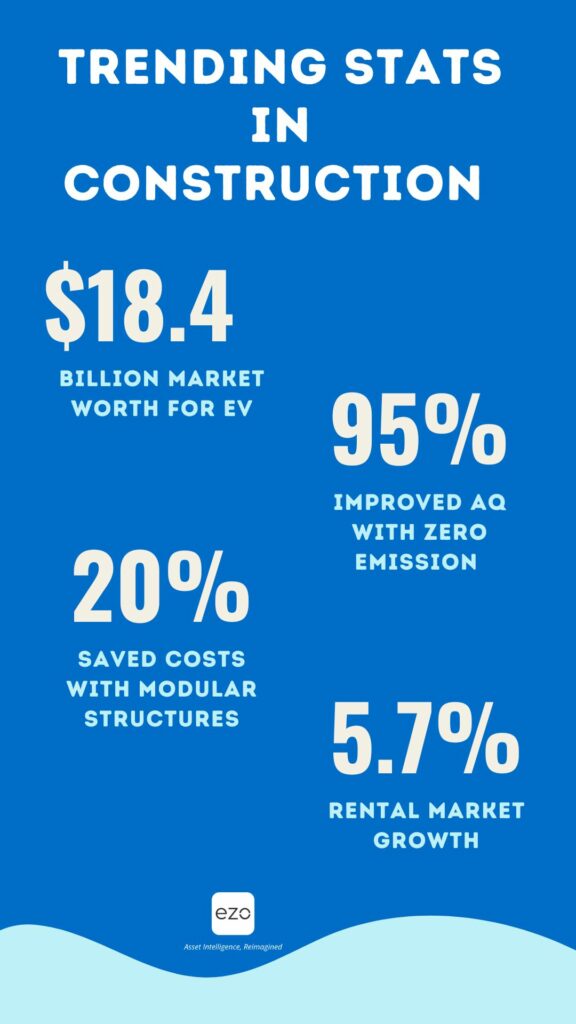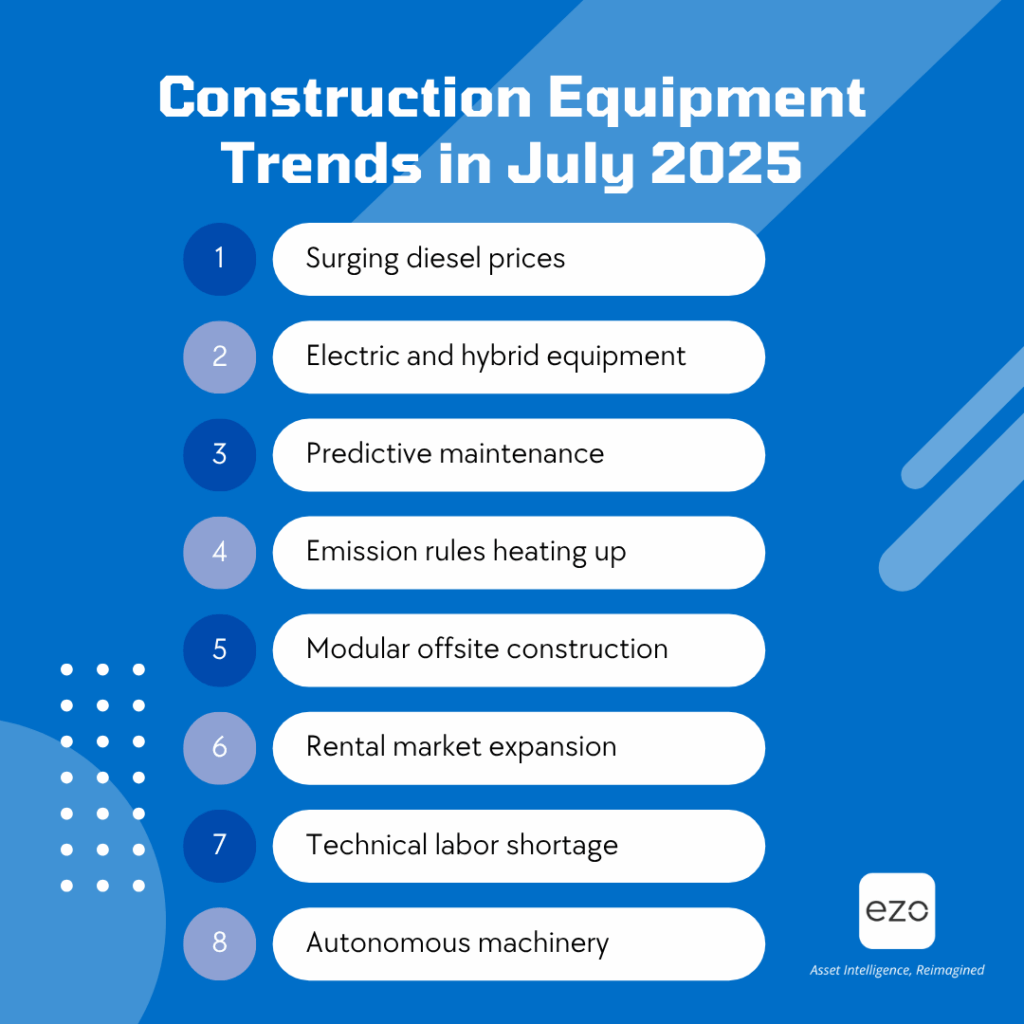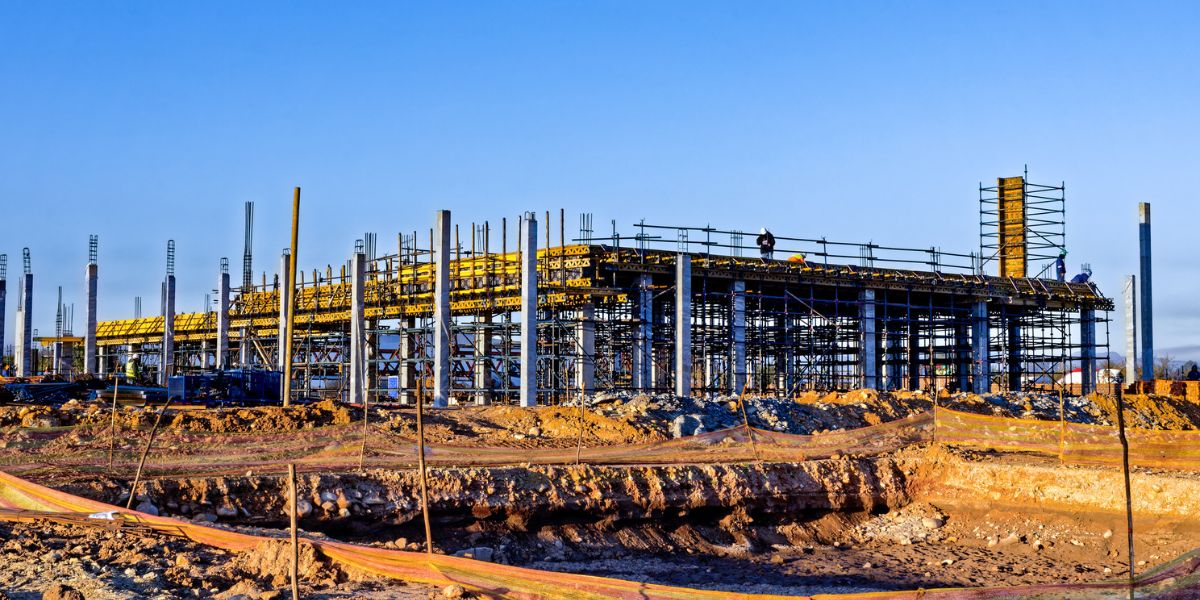Diesel prices are up again, squeezing your already tight budget for the year. New emission rules for construction fleets make it tougher to keep up with the latest requirements.
As a shop manager working for a construction GC, you’re trying to stay up-to-date but somehow still end up scrambling. Rising costs, new technology, and compliance regulations emerge periodically.
But how do they impact your job?
Fall behind, and the costs can spiral fast. Stay ahead, and you’re the superhero who keeps projects on track and budgets in check.
So, what exactly is next for construction equipment tracking in 2025? While you are busy booking excavators for your jobsite, we’ve prepared a list of trends shaping your fleet, budgets, and maintenance.
1. Diesel prices surge again. What does it mean for maintenance costs?
Diesel inventories have dropped sharply worldwide. U.S. distillate stocks are approximately 23% below their five-year average, and tightening refining capacity is pushing prices higher, especially as we head into the high-demand fall and winter season.
This results in a significant expense for fleet operations, where fuel accounts for 20-30% of total operating costs. Maintenance operations and equipment performance are likely to be negatively impacted in the following ways:
- Maintenance operations are likely to get deferred by rising diesel costs
- Rising fuel expense → Idle equipment → Rising wear and tear
- Budget pressure can prolong maintenance cycles beyond the recommended duration, increasing the likelihood of on-site breakdowns.
What can you do to survive the hike?
- Tack fuel consumption: Make optimal use of existing resources. Use an asset tracking software with meter-based tracking to gauge fuel consumption across assets. Investigate costs and prioritize efficient machines.
- Fine-tune maintenance cycles: Monitor maintenance cycles and target lubrication and tune-ups to make sure machinery is running efficiently and at all times.
2. Electric and hybrid equipment gaining ground
Driven by the agenda to reduce carbon emissions, electrification of construction equipment is gaining ground in the US.. The zero-emission project is expected to reach $18.4 billion by 2035. Equipment manufacturers such as Volvo CE, Caterpillar, and Case have launched compact electric models for excavators, loaders, backhoes, and mini truck loaders.
What does this mean for construction equipment managers?
Zero-emission machinery improves air quality by 95% as compared to diesel counterparts. But here is the catch: Electric equipment has a 50-100% higher purchase price as compared to diesel alternatives, with a limited battery life making deployment challenging.
If you are planning to adopt electric machines, here are some points to consider:
- Track battery health to avoid unscheduled downtime
- Coordinate with project infrastructure to accommodate charging at work sites
- Train your EV operators to ensure efficient machine use
Although the shift towards electric and hybrid seems like a challenging transition. But there is no denying that it is the future.
According to the Oslo mandate, electric machines are mandatory for those who wish to bid on public contracts. Despite high upfront costs, electric gear can reduce yearly costs by approximately 50%.

3. Predictive maintenance becomes essential
The ‘fix it when it breaks’ mindset is becoming outdated fast. It’s just a matter of time before fleet equipment managers adopt predictive maintenance where AI and machine learning help forecast failures before they actually happen. This is your game-plan to prevent costly downtimes and emergency work orders.
How to go from reactive → proactive maintenance?
- Start with pilot assets. Focus on critical machinery first which often results in costly repairs.
- Use telematics integration tools to populate maintenance data into your systems.
- Automate work order creation triggered by warning signs
- Create a KPIs dashboard to monitor trends and design maintenance strategy and budget around it
4. Emissions rules heating up
New emission regulations for construction trucks aim to drastically reduce NOₓ and CO₂ emissions through the use of advanced engine technologies, promoting zero-emission vehicles.
Both federal and state governments have laid down strict emission rules for commercial vehicles by rolling out the Clean Trucks Plan under the Environmental Protection Agency (EPA). The aim is to gradually replace all medium and heavy-duty trucks by 2035.
How does it impact equipment managers?
- California Air Resources Board (CARB) rules mandate a detailed log of engine tiers, retrolift installations, and fleet average emissions.
- All fleets operating in regulated states will by law require annual emission tests.
- Non-compliance risks now include heavy fines, project shutdowns, and delays
- You can take advantage of clear-air funds through early planning and execution
5. Modular offsite construction
Modular construction is on the rise with massive projects underway. The new technology offers a 40% time advantage over traditional construction, along with approximately 20% cost savings, achieved through lower labor costs and reduced raw material expenses.
The modular construction process involves fabricating 2D and 3D modules in controlled factory settings before transporting them to the project site.
Why is this important for equipment managers?
- It cuts downtime with fast assembly. Modular structures arrive on site and take only days to get completed, saving idle labor and machinery time
- No more chasing labor shortages. Offsite assembly reduces reliance on skilled on-site labor force.
- High quality results with more safety. Lesser chance of onsite accidents when assembly is done off-site.
6. Rental market expansion
The trend of renting equipment instead of purchasing is expected to increase. That’s not surprising given that 95% of equipment deployed by the commercial construction sector is all rented. In North America alone, the rented equipment market is expected to grow by 5.7%.
Why does this matter for shop managers in construction companies?
- You are in charge with complete cost visibility. Rental agreements are straightforward and transparent with usage-based billing
- No risk of aging equipment, as you can upgrade your rental agreement with changing demands
7. Skilled technicians are harder to find
According to the latest trends, the US needs to attract 454,000 workers to meet the growing demands of the construction industry. Approximately 94% of companies find it challenging to hire for critical positions. This isn’t something new for you. You have dealt with this every other year.
Training labor force the right way
The problem with labor shortage is skills mismatch.
Here are some pointers that can help you make the most of your crew:
- Track technician performance and use any insights to guide them to perform better.
- Deploy mobile apps, especially with offline access for faster and quicker actions with fewer delays in between.

8. Autonomous machinery gaining momentum
You struggle with finding the right people for the job site, and even then, there is an endless list of training that needs to be performed before work can actually start. With the rising trend of autonomous vehicles, you don’t have to worry about labor anymore.
AI agents installed on heavy machinery such as dozers, excavators, and forklifts means that equipment can operate with minimal human effort and even on off-hours. Autonomous vehicles deliver consistent performance and are ideal for hazardous tasks.
How can you get on board with autonomous vehicles?
- Start by categorizing high ROI equipment, such as forklifts and excavators that perform repetitive tasks.
- Partner with tech innovators to help you deploy autonomous vehicles for your high-value, time-sensitive projects.
- Pilot in flat terrains or quarry-like environments before expanding them to your job-site.
Stay ahead and in control of your construction equipment
The construction trends are evolving fast. Diesel prices spiking up, carbon emissions being tracked, and AI-powered diagnostics are reshaping how construction equipment works. These trends can impact budget and productivity, so it’s a good idea to start taking them into account while planning your workflows. Also, you can enhance productivity and reduce wastage with lean construction.
Rising fuel costs necessitate the optimization of fleet routes and resources to maximize fuel efficiency. Taking advantage of AI-powered vehicles can cut down costs through lower downtime and safer job sites. Staying ahead of the industry trends puts you in control of your equipment.
Want to prepare for these trends?
Discover how EZO helps construction teams reduce downtime, streamline maintenance, and gain full visibility into their fleet operations, before issues slow you down.
Explore EZO for Construction or book a quick demo to see how it works in the field.
Frequently Asked Questions
What are the biggest cost pressures in construction right now?
Rising material costs (lumber, steel), labor shortages, tariffs, and inflation are squeezing margins.
How are tariffs and supply chain delays affecting projects?
Delays in critical materials, increased lead times, and higher costs for imported components are pushing project schedules & budgets.
Why is demand slowing or becoming unpredictable in some regions?
Because of economic uncertainty, rising interest rates, inflation, and clients postponing non-essential projects.
How is sustainability influencing construction trends?
More focus on using eco-friendly materials, reducing waste, energy efficiency, and lifecycle cost rather than just upfront cost.
What technologies are contractors adopting more widely?
Increased use of IoT sensors, telematics on equipment, BIM (Building Information Modeling), drones for site surveying, and digital project management tools.
How important is rental equipment vs. ownership in current trends?
Renting heavy or specialty equipment is more common to avoid ownership costs, maintenance, and downtime. Flexibility is valued.
What safety trends are emerging in construction?
More training, real-time safety monitoring, stricter regulations, wearable safety tech, and site inspection digitization.
How is labor availability affecting construction workloads?
Labor shortages are delaying project start dates, increasing wages, increasing reliance on skilled subcontractors and pressure on productivity.
What role do digital tools / CMMS / maintenance software play in trend adoption?
They help reduce equipment downtime, improve maintenance scheduling, track utilization, and lower operational costs.
How do contractors manage cost overruns in current conditions?
They lock in material prices early, negotiate tariffs, build contingencies, improve estimating accuracy, and monitor equipment & asset usage closely.
Are modular or prefabricated methods becoming more common?
Yes — prefabrication helps reduce on-site labor, speed up build times, increase quality control, and often reduces waste.
What environmental or regulatory pressures are influencing construction projects?
Stricter building codes, emissions regulations, mandates for green building certifications, and mandates for energy efficiency are increasing.
How are contractors dealing with inflation in material & equipment sourcing?
They source locally when possible, order in bulk, pre-purchase materials when prices are lower, and use data to forecast price rises.
What are some emerging markets or segments in construction seeing growth?
Infrastructure (roads, bridges), sustainable/green construction, data center/industrial facilities, urban infill, renewal / retrofit market.
How is 3D/AR/VR or data visualization being used in construction?
For design review, clash detection, stakeholder alignment, site walkthroughs, virtual mock-ups—all to reduce errors and rework.
How do construction firms improve utilization of their equipment & fleet?
By tracking usage data, renting vs owning decisions, maintenance scheduling, condition monitoring, and avoiding idle equipment.
What project types are contractors more cautious about bidding on?
Long lead time projects, high material cost projects, high risk ones with uncertain regulation, or those heavily reliant on imports.
How can EZO tools help contractors keep up with construction industry trends?
EZO tools provide asset usage tracking, maintenance scheduling, data dashboards, equipment condition monitoring, helping contractors control costs, reduce downtime, and respond faster to market shifts.
Was this helpful?
- 1. Diesel prices surge again. What does it mean for maintenance costs?
- What can you do to survive the hike?
- 2. Electric and hybrid equipment gaining ground
- What does this mean for construction equipment managers?
- 3. Predictive maintenance becomes essential
- 4. Emissions rules heating up
- 5. Modular offsite construction
- 6. Rental market expansion
- 7. Skilled technicians are harder to find
- 8. Autonomous machinery gaining momentum
- Stay ahead and in control of your construction equipment
- Frequently Asked Questions
- What are the biggest cost pressures in construction right now?
- How are tariffs and supply chain delays affecting projects?
- Why is demand slowing or becoming unpredictable in some regions?
- How is sustainability influencing construction trends?
- What technologies are contractors adopting more widely?
- How important is rental equipment vs. ownership in current trends?
- What safety trends are emerging in construction?
- How is labor availability affecting construction workloads?
- What role do digital tools / CMMS / maintenance software play in trend adoption?
- How do contractors manage cost overruns in current conditions?
- Are modular or prefabricated methods becoming more common?
- What environmental or regulatory pressures are influencing construction projects?
- How are contractors dealing with inflation in material & equipment sourcing?
- What are some emerging markets or segments in construction seeing growth?
- How is 3D/AR/VR or data visualization being used in construction?
- How do construction firms improve utilization of their equipment & fleet?
- What project types are contractors more cautious about bidding on?
- How can EZO tools help contractors keep up with construction industry trends?









